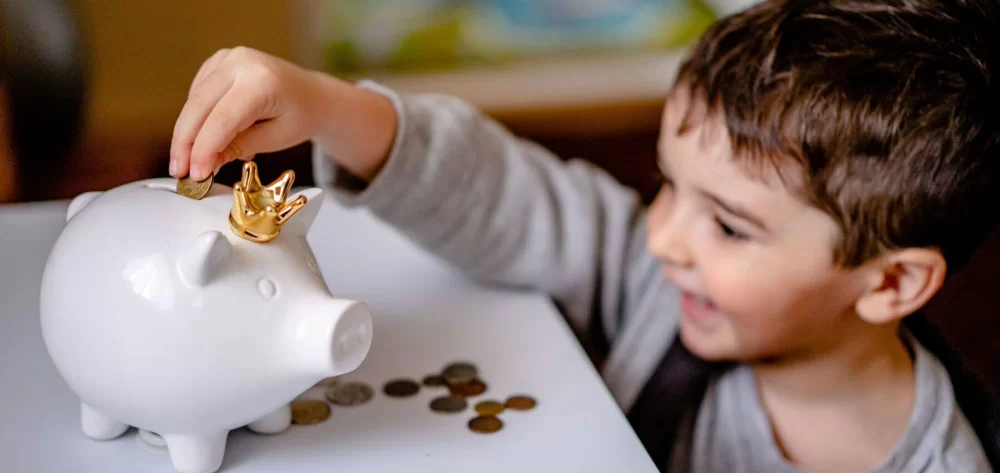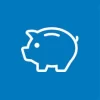Teaching children good financial habits can have a major impact on their future material wellbeing. But many parents are not sure where to start when it comes to teaching children about money. Here, moneyland.ch offers simple ideas for teaching kids the most important financial principles.
1. Read them a fairytale
A few examples of classic tales which teach financial principles include The Ant and the Cricket (saving and retirement planning), The Goose That Laid the Golden Eggs (investing), and Jack and the Beanstalk (taking advantage of opportunities). As kids get older, you can expand the learning effect by comparing the stories to real-life use cases.
2. Take your child shopping
Shopping excursions provide a unique, real-world opportunity for teaching children the value of money. Allow for plenty of time to visit different stores. Make a small list of shopping list items which interest your child (their favorite snacks, for example). At each shop, help your child note down the prices of items on the list. After visiting all the stores, compare the prices of each item and go buy them at the store where they are cheapest.
Young children can be introduced to the concept of having to pay to get things by helping you pay for your purchases. Using cash for this purpose will help your child understand that they are trading something (money) for the desired merchandise, and that money is not inexhaustible. Whether you pay in cash or using other payment methods, make a point of showing the child that you have a limited amount of money, and that you have less money after you spend.
3. Play make-believe
Role play provides a perfect platform to teach kids hands-on lessons that will stick with them for life. While letting your children play shop is a start, with a little more creativity and engagement, you can teach them more complex concepts like supply and demand, lending and borrowing, investing, and many more.
4. Get into gaming
Children learn best when they are having fun. Playing card and board games like Ciao Cash, Monopoly, Broker, the Game of Life and Cashflow with your kids opens many opportunities to discuss various aspects of finance. Computer games like Finance Mission Heroes are also worth looking at. Many games which are not specifically related to finance, such as certain card games and strategy games, also teach concepts which can be applied to finance. The same is true for video games. Note: Even the best financial education games are never completely realistic, so take time to point out differences between games and real life.
5. Give your child an allowance or offer them small jobs
In order for your child to learn how to handle finances, they have to have some money which they are fully responsible for. Consider giving your child an allowance or alternatively, offering them extra, paid jobs on top of their required chores. Giving your child room to make their financial decisions and mistakes provides them with valuable opportunities to learn. The Swiss pocket money calculator on moneyland.ch provides pocket money recommendations based on your child’s age and on where in Switzerland you live.
6. Use piggy banks
Young children in particular need to learn to see money as something tangible, valuable, and limited. Using piggy banks is an easy way to accomplish this. You can strengthen the child’s emotional link to money by helping them make their own custom piggy banks using their own imagination. By having separate piggy banks for different kinds of spending, as well as saving, investing, and charitable giving, your child can learn the fundamental principles of budgeting.
7. Help your kids earn an income
Earning an income from outside of the home is key to learning about how markets, supply, and demand work.
In Switzerland, children are legally allowed to hold part-time paid jobs from the age of 13, as long as it is a safe, non-demanding job which does not impede their development or education. The income earned belongs to the child. Babysitting, simple and safe farm work, mowing lawns and basic gardening are some examples of jobs for young teens which are available in most of Switzerland.
But you can begin helping your child earn income for themselves long before they turn 13. Selling their unneeded toys or sports equipment on classifieds websites, or at community exchanges or flea markets is a good way to start. If you have a garden, growing and selling vegetables is an ideal platform for helping children understand value creation. Helping your child make handicrafts which can be sold online (or at markets, if you are so inclined) is another option.
8. Make use of educational resources
There are numerous activities, videos, and worksheets which are freely available and can make teaching kids financial literacy a lot easier. Websites which cater to teachers (like Zebis) are a good place to start your search. Many Swiss banks include educational activities about money on their websites, or in the complimentary magazines they send to youth account holders. You can also find many books designed to teach personal finance basics and more advanced financial concepts to children in different age groups. Take a look at the guide to saving money on books for useful tips.
9. Show children how cashless transactions work
Private accounts, credit cards, debit cards, and mobile payments are widely used in Switzerland, so it is important that children learn how cashless transactions work. Without enough clarification, bank accounts and cashless payment methods can appear to children as bottomless sources of free money.
Role-playing games and visual aids can help you explain cashless transactions in an understandable and memorable way. For example, your child plays the banker who keeps your money for you (the shopper) and passes it on to a “shopkeeper” every time you pay with your card, until there is no money left in your account.
You can also use personal finance management (PFM) tools for kids to teach children about banking using real money. PFM apps for kids are normally linked to a private account, so using them only makes sense if you are ready to let your child have and use a bank account. They generally come with a separate app which lets you as the parent monitor activity, set criteria for the transfer of allowances, and many other functions.
Currently, the Finny PFM (beta version) from Swiss startup Fintune is one of the only Swiss child-oriented PFMs which can be linked to any youth bank account. Others are only available with specific bank accounts. These include Minibank (St. Galler Kantonalbank), Yapini from Yapeal, and GKB Gioia Kids (Graubündner Kantonalbank). UK-based neobank Revolut, which is relatively popular in Switzerland, also includes PFM software in its account for kids.
10. Teach your child to invest
Many children never learn how to invest, and this educational gap often results in lifelong financial handicaps. Encouraging your child to invest part of their pocket money will teach them to think long-term rather than hand-to-mouth.
Savings accounts for kids are the simplest and least-risky investment tool.
Fund savings plans for children provide a simple way for your child to invest in the stock market. Swiss banks usually refer to these as gift savings plans or youth savings plans, and some of these have more favorable conditions than standard products. Unlike savings accounts, your child owns shares in funds or stocks, and can watch the value of their assets shrink and grow along with the stock market.
For older children, opening a free demo account on a Swiss online trading platform gives you a simple way to teach children about the stock and bond markets without risking real money.
11. Talk about the ecological and social impact of money
The way we spend and invest money determines what kind of world we live in, and children can learn to understand this concept. Talk to children about things like:
-
How consumer goods are made, and under which working conditions.
-
Where resources used for goods and services come from, how much of a resource is available, how it is obtained, and how obtaining it impacts the environment. Focus on things the children want or use, including immaterial things like entertainment.
-
Where the food you eat comes from, and how it is grown.
-
What happens to things which you throw away, what resources were used to make them, and how your garbage impacts the environment.
-
How money can be used to further causes you care about through investing or donating.
-
The impacts of theft and corruption.
Openly discussing these things will help children understand the impact of their financial behavior on the world we live in.
12. Teach your children how to give
Teaching children how to give responsibly has a positive impact on their long term financial and emotional wellbeing, as a number of studies have shown. Volunteering, for example, helps to expand your child’s social circle and skills set. Teaching your child to set money aside to donate simultaneously teaches them budgeting. Giving can also help instill in your child a broader view of money as a tool to influence the world, rather than just a way to obtain consumer goods and services.
A simple way to teach your child about giving is to have a piggy bank just for money designated to give away. At regular intervals (once a month, for example), sit down with your child and let them decide how to donate the saved money.
Encouraging your child to volunteer is another way to teach giving. Volunteering can be as simple as (safely) collecting litter together. Many Swiss neighborhood associations and clubs offer volunteering activities for kids which you can take advantage of.
13. Use prepaid mobile with limited credit
If you plan to let your older child have their own phone, consider using a prepaid mobile SIM with a fixed amount of prepaid credit. Letting your child decide how to use these credits will help them learn the basics of budgeting.
14. Visit museums
For older children, museums provide an interesting platform for learning about money while enjoying a family excursion. The Schweizer Finanzmuseum in Zurich is dedicated completely to financial education. The History of Money in Zurich tour guides participants through Zurich’s development as a financial center. The Swiss Customs Museum in Ticino provides insights into customs and tariffs. Many historical museums also provide insights into things like trade, economics, and currency. Financial museums exist in many popular travel destinations as well, including Austria (the Financial Life Park in Vienna), France (the Citéco in Paris), Germany (the Money Museum in Frankfurt), the United Kingdom (the Bank of England Museum in London), and other countries.
More on this topic:
Financial tips for families in Switzerland
Smartphones for kids: Tips for parents
Dental insurance: A practical guide
Health insurance discounts for families explained
Family mobile plans in Switzerland







